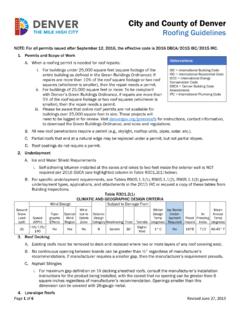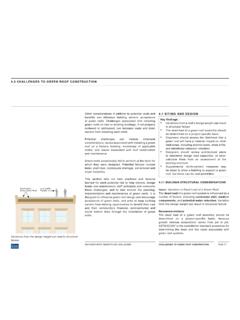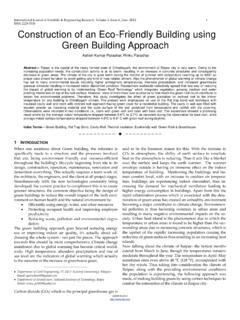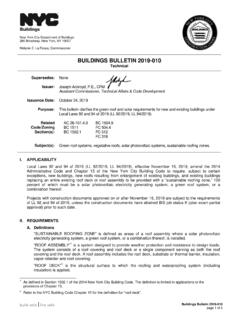Transcription of THE HOUSEHOLDER’S GUIDE TO FLAT ROOFING
1 THE HOUSEHOLDER'S. GUIDE TO FLAT ROOFING . CONTENTS. INTRODUCTION 2. BASIC DESIGN 3. WARM AND COLD ROOFS 3. ESSENTIALS FOR A SUCCESSFUL FLAT roof 4. MAINTENANCE 5. INSPECTION CHECKLIST 5. WILL A REPAIR BE SUFFICIENT? 6. RE- ROOFING THE OPTIONS 6. CHOOSING THE RIGHT MATERIALS 7. FOR THE STRUCTURAL DECK 7. FOR THE VAPOUR CONTROL LAYERS 7. FOR THE INSULATION MATERIALS 8. WATERPROOF COVERING 9 REINFORCED BITUMEN MEMBRANES (RBM) 9. SINGLE PLY 10. LIQUID APPLIED SYSTEMS 11. FINDING A CONTRACTOR 13. OBTAINING QUOTATIONS 13. BEFORE THE WORK STARTS 13. GUARANTEES 14. FURTHER INFORMATION 15. Every effort has been made to ensure the accuracy of the information in this publication. The National Federation of ROOFING Contractors (NFRC), Single Ply ROOFING Association (SPRA) and the Liquid ROOFING and waterproofing Association (LRWA) have not verified the information by independent testing nor has any control over the circumstances in which it will be used.
2 They, their officers, employees or members cannot therefore accept any liability arising out of its use. INTRODUCTION. This GUIDE has been produced by the Industry for Householder's with minimal ROOFING knowledge. By providing information on the design, materials, construction and maintenance of successful flat roofs; we hope it will assist to a satisfactory roof renewal. Traditionally, domestic flat roofs use two or more built up layers of bituminous felt as their weather proofing. Liquid applied systems such as glass fibre were introduced and are now quite widely used. Single Ply membranes are also used but are particularly suitable for larger roofs. Bitumen membranes are still the most used system and are of much higher quality than those used in previous decades and are now known as Reinforced Bitumen Membranes (RBM). Mastic asphalt is occasionally used but, because of its weight, has to have a much stronger roof construction.
3 Sadly there are still some inexperienced contractors producing poor results in residential ROOFING . However, given good quality materials, installation by reputable contractors with trained certificated operatives, and simple maintenance, the householder can be assured of a dependable and long-lasting roof . 2 Householder's GUIDE to Flat ROOFING BASIC DESIGN. In a flat roof , the waterproofing is always supported by a structural roof is usually a timber boarding of some type, which in turn is supported on joists. The ceiling, if any, is usually fixed directly to the underside of the joists. Garages may be un-insulated, but most roofs above the habitable part of the house will be insulated to comply with Building Regulations. In houses the insulation is sometimes placed immediately above the ceiling. Preferably, it may be placed above the deck before the application of the waterproofing (see below, and the note under Re- ROOFING the options' on page 6).
4 Some specialised insulations can also be placed above the waterproofing , but this sort of construction is normally confined to commercial and industrial buildings and has very seldom been used on domestic buildings. In almost all cases where RBM has been installed, the surface of the waterproofing will need protection, both from ultraviolet light and from fire from external sources. The Building Regulations lay down the degree of protection required in the case of fire. This can be achieved by adding a layer of mineral chippings bedded in compound to the surface of the roof , or alternatively by using a mineral surfaced layer of RBM as the top layer, or Capsheet'. Liquid applied and Single layer systems have this protection built in and do not require additional protection. WARM AND COLD ROOFS. The construction of the roof deck and ceiling has an important effect on the behaviour of the waterproofing material on top. The building industry uses the terms WARM roof and COLD roof to describe the two different types.
5 In Britain as a whole, the WARM roof is strongly recommended. WARM roof . This type of construction has the insulation above the roof deck, thus keeping the deck WARM'.This is usually the most satisfactory construction for domestic properties as it avoids the need for ventilation of the roof membrane is then attached to the insulation. A typical warm roof is shown in the sketch below. Sketch 1. Householder's GUIDE to Flat ROOFING 3. COLD roof . Many residential flat roofs have the waterproofing laid directly onto the deck, and any insulation placed above the ceiling. This arrangement allows the deck to become COLD'. In cold weather, such roofs are inherently prone to condensation, which can cause materials to decay and reduce this risk, through-ventilation has to be provided to each and every space above the insulation but this is often difficult to achieve, for example if the roof abuts the wall of a house. Cold roofs should not be endorsed for the climatic conditions in Scotland, according to the Building Standards (Scotland) Regulations.
6 Although the Regulations do not prevent the use of cold roof constructions, warm roof constructions are recommended. Sketch 2. If you have an existing cold roof in need of refurbishment, it should be converted to a warm roof (see Sketch 1) to meet part L of the Building Regulations. ESSENTIALS FOR A SUCCESSFUL FLAT roof . Like any part of a building's exterior, flat roofs should be constructed to withstand natural and human forces with the minimum of attention. The following general guidance can be confirmed by the specific membrane manufacturer. Protection from Rain and Snow The finished roof should have a slope of at least 1 in 80. To achieve this, a design fall of 1 in 40 or 1 in 60 is advised. It is best to drain the roof to one or two edges. Conventional gutters are better than internal outlets. Internal outlets should be adequately sized to deal with storm conditions and be fitted with leaf and gravel guards. The waterproofing should extend up adjacent walls at least 150mm (6in) from the roof surface in all situations.
7 The top edge of the waterproofing system should be protected by a cover flashing appropriate to the membrane. Protection from Sun and Frost It pays to insulate: heating bills are lower throughout the year and rooms are cooler in the summer. Insulation of new flat roofs must satisfy Part L of the Building Regulations. Since April 2006, this also applies to refurbishment of flat roofs. Bitumen membranes should be protected from the sun (see Surface Protection section). 4 Householder's GUIDE to Flat ROOFING Protection from Condensation It is essential that cold roofs include adequate through-ventilation of all joist voids etc. Warm roofs always require a robust vapour control layer (VCL), bonded directly to the deck. Protection from the Wind All roofs, including insulation and membrane, should be constructed to resist wind forces. An experienced contractor will be able to advise. Seek his advice if your roof is particularly exposed.
8 Protection from People Materials should be selected to suit roof usage. If regular foot traffic is expected a surface protection must be provided. If the use is changed, to a roof terrace, the structure may have to be strengthened. Protection from Fire Consult your local authority if you are planning a new flat roof . Most flat roof systems will meet the Regulations, but check with your contractor. MAINTENANCE. All parts of a building benefit from care and regular checks: We Recommend Limited access unless the roof is designed for it. If occasional access is required, for window cleaning, make sure that temporary boards are used unless the roof surface is designed to accept it. Inspection twice a year, in March and November. Try to do one inspection soon after rain, to see how well the water is draining away. Before attempting any inspection, please ensure that access is safe, and that if a ladder is necessary it is well secured.
9 If you are unsure use a Competent Person. If you are unsure of the condition of the deck, do not step onto the roof . INSPECTION CHECKLIST. Some of the these items can be rectified by the Householder, for example;. Check gutter and outlets are free from debris Others may need checking such as: Puddles and blisters - the householder will need to record the size and position to assess whether they are getting larger. Check upstand and adjacent details for problems. Some will need to be checked and reported to the contractor if there are any signs of failure: Protective finish (remedy bare patches as necessary). Upstands and flashing (check condition). Joints (check condition). Edge Trims (check condition). Sagging of decks and/or joists (check condition). It is important that any failure of these details is reported to the contractor to avoid any subsequent water ingress and the temptation to do-it-yourself as this may invalidate any guarantee on the roof .
10 Householder's GUIDE to Flat ROOFING 5. WILL A REPAIR BE SUFFICIENT? If the roof is out of guarantee then patch repair compounds are useful because they give the householder time to organise re- ROOFING for a competitive price at the right time of year, however, always ensure that the compound is compatible with the membrane. But in general, such repairs are only short term and worthwhile if they are cheaper than the effective cost per year of a new roof covering. If it is still covered by a guarantee, contact your ROOFING contractor or you may invalidate the guarantee. Other factors to consider in deciding whether to re- roof are: The type and age of the present covering (if you are a recent purchaser, try to find out from the vendor). The history of the roof - if all past repairs have been in the same place, complete re- ROOFING may not be necessary. If you wish to improve the insulation performance of the roof - lower heating bills will reduce the annual cost.





